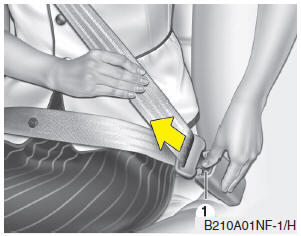 Hyundai Veloster: Shoulder belt extension guide
Hyundai Veloster 2011-2017 Owner's Manual / Safety features of your vehicle / Seat belts / Shoulder belt extension guide
Hyundai Veloster: Shoulder belt extension guide
Hyundai Veloster 2011-2017 Owner's Manual / Safety features of your vehicle / Seat belts / Shoulder belt extension guide

You can adjust the position of the shoulder belt extension guide for easier access to the shoulder belt.
Set the belt extension guide to the position (1~3) when using the seat belt.
WARNING
- • Verify the shoulder belt anchor is locked into position at the appropriate height. Never position the shoulder belt across your neck or face. Improperly positioned seat belts can cause serious injuries in an accident.
- • Failure to replace seat belts after an accident could leave you with damaged seat belts that will not provide protection in the event of another collision leading to personal injury or death. Replace your seat belts after being in an accident as soon as possible.

WARNING
You should place the lap belt portion as low as possible and snugly across your hips, not on your waist. If the lap belt is located too high on your waist, it may increase the chance of injury in the event of a collision. Both arms should not be under or over the belt. Rather, one should be over and the other under, as shown in the illustration. Never wear the seat belt under the arm nearest the door.
Seat belts - Front passenger and rear seat 3-point system with combination locking retractor
To fasten your seat belt:
Combination retractor type seat belts are installed in the rear seat positions to help accommodate the installation of child restraint systems. Although a combination retractor is also installed in the front passenger seat position, it is strongly recommended that children always be seated in the rear seat. NEVER place any infant restraint system in the front seat of the vehicle.
This type of seat belt combines the features of both an emergency locking retractor seat belt and an automatic locking retractor seat belt.To fasten your seat belt, pull it out of the retractor and insert the metal tab into the buckle. There will be an audible "click" when the tab locks into the buckle. When not securing a child restraint, the seat belt operates in the same way as the driver's seat belt (Emergency Locking Retractor Type). It automatically adjusts to the proper length only after the lap belt portion of the seat belt is adjusted manually so that it fits snugly around your hips.
When the seat belt is fully extended from the retractor to allow the installation of a child restraint system, the seat belt operation changes to allow the belt to retract, but not to extend (Automatic Locking Retractor Type). Refer to “Using a child restraint system” in this section.
✽ NOTICE
Although the combination retractor provides the same level of protection for seated passengers in either emergency or automatic locking modes, it is recommended that seated passengers use the emergency locking feature for improved convenience. The automatic locking function is intended to facilitate child restraint installation. To convert from the automatic locking feature to the emergency locking operation mode, allow the unbuckled seat belt to fully retract.

To release the seat belt:
The seat belt is released by pressing the release button (1) in the locking buckle. When it is released, the belt should automatically draw back into the retractor. If this does not happen, check the belt to be sure it is not twisted, then try again.
 Seat belt restraint system
Seat belt restraint system
WARNING
• For maximum restraint system protection, the seat belts must always
be used whenever the car is moving.
• Seat belts are most effective when seatbacks are in the upright positio ...
 Pre-tensioner seat belt
Pre-tensioner seat belt
Your vehicle is equipped with driver's and front passenger's pre-tensioner seat
belts. The purpose of the pre-tensioner is to make sure that the seat belts fit
tightly against the occupa ...
See also:
Center console storage
These compartments can be used to store small items required by the driver or
front passenger.
To open the center console storage pull up the lever. ...
Power Door Lock Actuators. Repair procedures
Inspection
Front Door Lock Actuator Inspection
1.
Remove the front door trim.
(Refer to the BD group - "Front door")
2.
R ...
Emergency trunk safety release
Your vehicle is equipped with an emergency trunk release cable located inside
the trunk. The lever glows in the dark when the trunk lid is closed. If someone
is inadvertently locked in the trunk ...
Categories
- Hyundai Veloster Manuals Home
- Hyundai Veloster 2010-2017 Owner's Manual
- Hyundai Veloster 2010-2017 Service Manual
